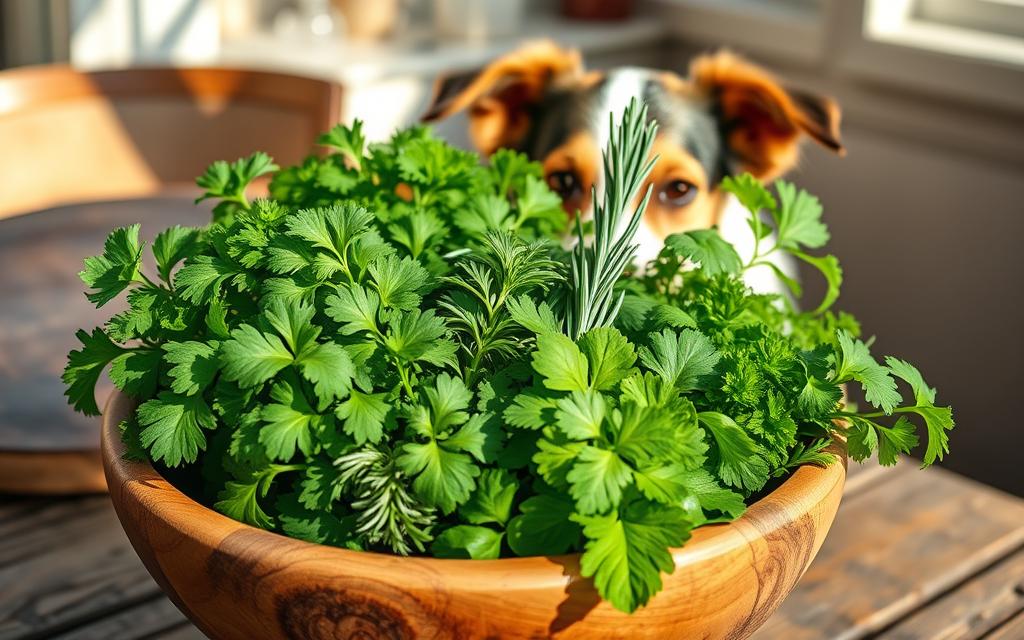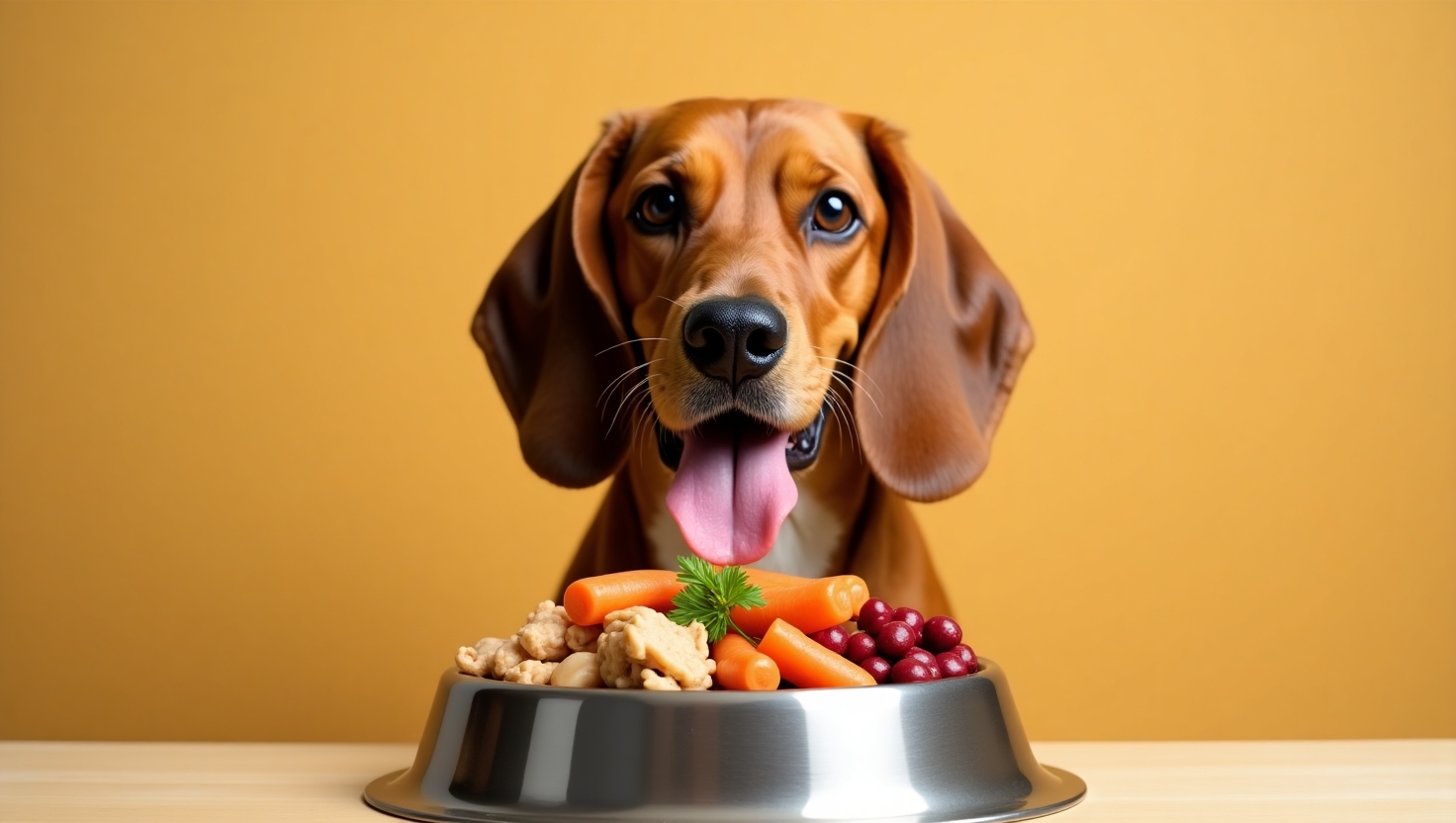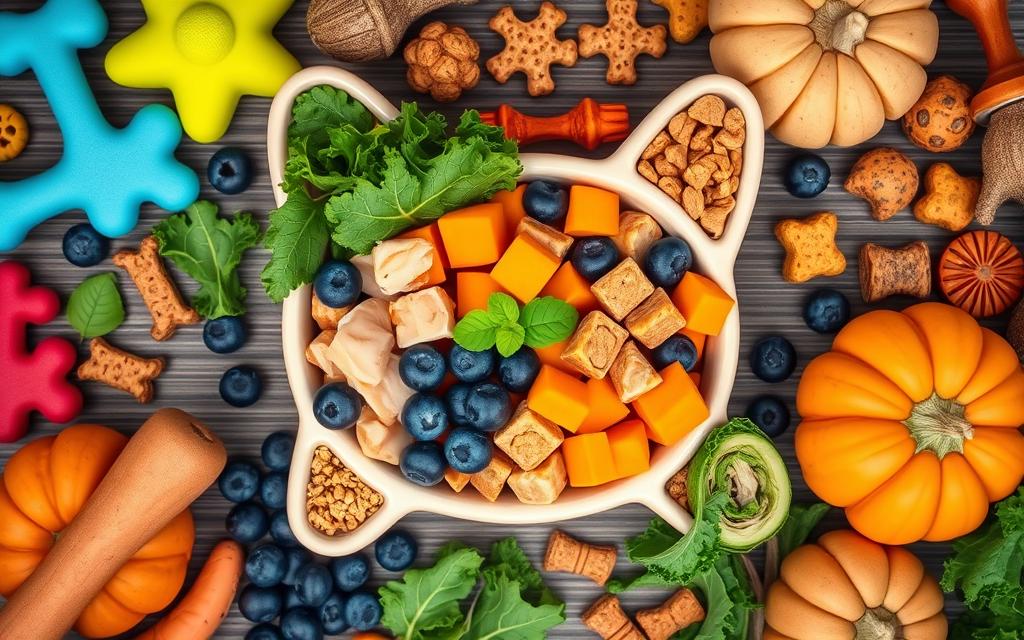Best Homemade Dog Food: Nutritious Meals Your Pup Will Love
As a dog owner, I always want the best for my furry friend. That means giving them nutritious meals that meet their needs. Homemade dog food is a great way to do this. It lets me tailor meals to their likes and needs.
By making their food myself, I control what they eat. I use fresh ingredients like lean ground sirloin and brown rice. I also add dog-friendly veggies for extra nutrition. This way, my dog gets healthy, tasty meals.
Switching to homemade food helps my dog stay healthy. It prevents many ailments and boosts their overall health. I can get creative with ingredients like parsley and olive oil. This way, my dog enjoys their meals while getting the nutrients they need.
Key Takeaways
- Homemade dog food allows for tailored nutrition and ingredient control, which is essential for dog food nutrition.
- Fresh, wholesome ingredients like lean ground sirloin and brown rice are great for homemade dog food.
- Dog-friendly vegetables like carrots and green beans can be added to homemade dog food for extra nutrition.
- Homemade dog food can help prevent ailments and improve overall health, making it a great option for dog food nutrition.
- With a little planning, I can create a variety of delicious and healthy meals for my dog using homemade dog food and dog food nutrition principles.
- Homemade dog food can be stored in the freezer for weeks or in the fridge for a few days, making it a convenient option.
Why Switch to Homemade Dog Food
Switching to homemade dog food has greatly improved my dog’s health. I’ve seen a big boost in energy levels and a shinier coat right away. It’s because I understand dog food nutrition better, allowing me to make meals just right for my pet.
Benefits of Fresh Ingredients
Using fresh ingredients means my dog gets top-notch nutrients. Whole foods cut down on processed stuff, helping with digestion and health.
Control Over Nutrition Quality
By making meals myself, I have full control over what my dog eats. I can make sure they get the right mix of proteins, fats, and vitamins. This helps keep them healthy and happy.
Cost Effectiveness Long-term
Homemade dog food might take more time at first, but it saves money in the long run. Buying ingredients in bulk and making meals ahead of time can really cut costs.
| Benefit | Impact |
|---|---|
| Improved Energy Levels | Enhanced activity and playfulness |
| Shinier Coat | Healthier skin and fur |
| Overall Health | Stronger immune system and vitality |
Essential Nutrients Your Dog Needs Daily
It’s crucial to make sure your dog gets the right dog food nutrition for their health and happiness. When making homemade dog food, mix in all the essential nutrients your pup needs.
- Proteins: Proteins help build and fix tissues. Use ground beef, chicken, and fish as good sources.
- Carbohydrates: They give energy. Add grains like brown rice or veggies like sweet potatoes.
- Fats: Fats are a great energy source and help with vitamin absorption. Choose healthy fats like fish oil.
- Vitamins and Minerals: They support body functions. Include fruits and veggies like blueberries and carrots.
- Water: Always have fresh, clean water for your dog to stay hydrated.
By balancing these nutrients, you can make homemade dog food that keeps your dog healthy and full of energy.
Safe and Unsafe Ingredients for Homemade Dog Food
Making homemade dog food lets you customize meals for your dog. It’s important to pick the right ingredients for their health and happiness.
Approved Protein Sources
- Chicken
- Beef
- Turkey
- Fish like salmon and tuna
- Eggs
Recommended Vegetables and Fruits
- Carrots
- Sweet potatoes
- Green beans
- Apples (without seeds)
- Blueberries
Foods to Avoid
- Chocolate
- Grapes and raisins
- Onions and garlic
- Avocado
- Macadamia nuts
| Category | Safe Ingredients | Unsafe Ingredients |
|---|---|---|
| Proteins | Chicken, Beef, Fish | Processed meats with additives |
| Vegetables | Carrots, Sweet Potatoes | Onions, Garlic |
| Fruits | Apples, Blueberries | Grapes, Raisins |
| Nuts | None | Macadamia Nuts |
| Other | Eggs | Chocolate, Avocado |
Basic Equipment Needed for Making Dog Food
Preparing homemade dog food is easier with the right tools. The proper equipment helps you make nutritious meals quickly and safely for your pet.
A food processor is key. It chops veggies and mixes ingredients well, speeding up prep. A good Dutch oven is also vital for cooking meals evenly. This ensures all nutrients are kept.
Accurate measurements are key. Measuring cups help you follow recipes exactly. This keeps the right balance of proteins, veggies, and grains in your dog’s food. You’ll also need meal prep containers to store the food. They keep it fresh in the fridge or freezer.
Getting these basic tools makes making homemade dog food easy and fun. With the right gear, you can give your dog balanced and tasty meals that meet their needs.
- Food Processor: $230 on Amazon
- Dutch Oven: $47 on Amazon
- Measuring Cups: Available at most kitchen stores
- Meal Prep Containers: Various sizes on Amazon
The Perfect Homemade Dog Food Recipe
It’s easy to make healthy meals for your dog. Here are 3 homemade dog food recipes that your pup will love. Each recipe is balanced and tailored to your dog’s needs.
Recipe 1: Ground Turkey and Veggie Mix
- 2 lbs ground turkey
- 1 cup sweet potatoes, diced
- 1 cup carrots, chopped
- 1 zucchini, sliced
- 1 cup macaroni
Brown the ground turkey in a large pot. Add sweet potatoes, carrots, and zucchini, cooking until tender. Stir in macaroni and simmer for 15 minutes. Let it cool before serving.
Storage Tips: Refrigerate for up to 5 days or freeze in individual portions using Souper Cubes.
Recipe 2: Beef and Brown Rice Stew
- 2 lbs organic grass-fed ground beef
- 1 cup brown rice
- 1 cup broccoli, chopped
- 1 bell pepper, diced
- 3 eggs
In a large skillet, cook the ground beef until done. Add brown rice and water, bringing to a boil. Reduce heat and add broccoli and bell pepper. Cook until rice is tender. Stir in eggs and allow to set.
Storage Tips: Keep in the fridge for up to 7 days or freeze for up to 6 months.
Recipe 3: Chicken and Spinach Blend
- 2 lbs chicken breasts, cooked and shredded
- 2 cups spinach, chopped
- 1 cup lentils
- 1/2 cup carrots, grated
- 1/4 cup flax oil
Combine cooked chicken, spinach, lentils, and carrots in a large bowl. Mix thoroughly and drizzle with flax oil for added omega-3s. Serve fresh or portion out for later.
Storage Tips: Store in the refrigerator for up to 5 days or freeze for convenient future meals.
Tailoring Portions to Your Dog’s Size
Finding the right portion sizes is key for your dog’s health. With homemade dog food, you control every ingredient. This ensures your dog gets the best dog food nutrition.
Feed your dog 2-3% of their body weight each day. For instance, a 20-pound dog needs about 1 cup of homemade food daily.
But, other things like breed size, age, and how active they are can change these amounts. Here’s a detailed breakdown:
| Dog Weight | Daily Portion | Meals Per Day |
|---|---|---|
| Up to 10 lbs | 1/2 – 1 cup | 2-3 |
| 11-20 lbs | 1 – 1.5 cups | 2-3 |
| 21-40 lbs | 1.5 – 2 cups | 2-3 |
| 41-70 lbs | 2 – 3 cups | 2-3 |
| 71+ lbs | 3+ cups | 2-3 |
Other things to think about include how much energy your dog uses, their gender, health, and if they’re pregnant. Watching your dog’s weight and body condition helps adjust portions as needed.
Talking to a vet can give you tailored advice. They can help make sure your pet gets the right amount of dog food nutrition without overfeeding.
Transitioning Your Dog to Homemade Food
Switching to homemade dog food can greatly benefit your pet’s health. To ensure a smooth change, it’s essential to introduce the new diet gradually. This helps prevent digestive issues and makes the transition easier for your furry friend.
Creating a Transition Schedule
Start by mixing a small amount of homemade dog food with your dog’s current diet. Over the course of a week, gradually increase the homemade portion while decreasing the commercial food. Here’s a suggested 7-day plan:
| Day | Commercial Food | Homemade Dog Food |
|---|---|---|
| 1 | 75% | 25% |
| 2 | 60% | 40% |
| 3 | 50% | 50% |
| 4 | 40% | 60% |
| 5 | 30% | 70% |
| 6 | 20% | 80% |
| 7 | 0% | 100% |
Monitoring Your Dog’s Response
Keep a close eye on your dog’s behavior and digestion during the transition. Look for signs like changes in stool consistency, energy levels, and appetite. Regularly weigh your dog to ensure they maintain a healthy weight. If you notice any adverse reactions, consult your veterinarian promptly.
`: Common Mistakes to Avoid When Making Dog Food – Introductory paragraph highlighting the importance of avoiding mistakes in homemade dog food preparation.
Common Mistakes to Avoid When Making Dog Food
Making homemade dog food can be rewarding but mistakes can harm your dog’s health. Knowing these mistakes helps ensure your pet gets the best nutrition.
Nutritional Balance Errors
One big mistake is not balancing nutrients. The Association of American Feed Control Officials (AAFCO) has 37 guidelines for dog nutrition. Without following these, your dog’s dog food nutrition might be off, causing health problems.
Preparation Mistakes
Bad preparation can also be risky. Not cooking ingredients well can lead to bacteria. Also, wrong storage can spoil food. Always keep leftovers in airtight containers in the fridge for five days or freeze for six months.
Another error is substituting ingredients without a vet’s advice. This can upset the nutrient balance. Stay away from harmful ingredients like artificial preservatives, xylitol, garlic, and onions to keep your dog safe and healthy.
Seasonal Recipe Variations
Changing up your dog’s homemade meals with the seasons keeps things interesting and healthy. Adding seasonal fruits and veggies brings new tastes and nutrients. This makes sure your dog gets the best for each time of year.
In spring, try adding spinach and blueberries to their meals. These are packed with vitamins and antioxidants. Summer is the time for cool veggies like cucumbers and sweet treats like watermelon.
Fall is great for warm, comforting foods like sweet potatoes and pumpkin. Winter meals can include hearty greens like kale and apples.
- Spring: Spinach, blueberries
- Summer: Cucumbers, watermelon
- Fall: Sweet potatoes, pumpkin
- Winter: Kale, apples
Using the best dog food recipe for each season helps keep your dog healthy. Try our 3 homemade dog food recipes with these seasonal ingredients. It will make your furry friend happy and healthy all year.
Conclusion: Making the Switch to Healthy Homemade Dog Food
Switching to homemade dog food can really change your pet’s health. I’ve seen how fresh ingredients boost their energy and make their coat shine. You get to control what goes into their meals.
Resources like Cola’s Kitchen and Dog Child make it easy to create balanced meals. They help avoid any guesswork, ensuring your dog gets all the nutrients they need. Keeping food fresh and stored properly is simple and prevents any health issues.
Many dog owners have already switched to homemade food. Studies show dogs on homemade diets have fewer health problems and are happier. Choosing homemade food means a healthier, happier life for your dog.
Ready to make a change? Start with a simple recipe and see the positive effects on your dog. Getting the right balance is important, and experts can help if needed. Embrace homemade dog food and watch your dog thrive with better nutrition and energy.
FAQ
What are the benefits of switching to homemade dog food?
Homemade dog food lets you use fresh ingredients. This gives you control over your pet’s nutrition. It can improve your dog’s health and coat.
It also boosts their energy and can save money in the long run. Many pet owners see fewer allergies and better digestion after switching.
How does homemade dog food improve my dog’s health?
Homemade dog food uses fresh, high-quality ingredients. It’s free from preservatives and artificial additives. This ensures your dog gets essential nutrients.
These nutrients include proteins, carbohydrates, fats, vitamins, and minerals. They help your dog stay healthy and have a strong immune system.
What essential nutrients does my dog need daily?
Dogs need a balanced diet. This includes proteins for muscle, carbohydrates for energy, and fats for a healthy coat. They also need vitamins and minerals for bodily functions.
Homemade dog food lets you tailor the nutrient profile to your dog’s needs.
What ingredients are safe to include in homemade dog food?
Safe protein sources include chicken, beef, and fish. Vegetables and fruits like carrots, sweet potatoes, and apples are good too. Just make sure to remove seeds from apples.
Blueberries are also a nutritious addition. Always use fresh ingredients and prepare them properly.
Are there any foods I should avoid when making homemade dog food?
Yes, some foods are harmful to dogs. Avoid onions, garlic, grapes, raisins, chocolate, and artificial sweeteners like xylitol. These can cause serious health issues.
Make sure to exclude them from your homemade dog food recipes.
What kitchen equipment do I need to prepare homemade dog food efficiently?
You’ll need a chef’s knife, cutting board, large pots, measuring cups and spoons, a food processor, and storage containers. These tools help prepare ingredients safely and store meals properly.
Can you share some of the best homemade dog food recipes?
Yes! I have three delicious and nutritious homemade dog food recipes. They cater to different dietary needs. Each recipe includes ingredient proportions, cooking instructions, and storage tips.
How do I determine the right portion sizes for my dog?
Portion sizes depend on your dog’s size, weight, and activity level. I use guidelines and formulas to calculate the right amount. This ensures your dog gets the right nutrition without overfeeding.
What is the best way to transition my dog from commercial to homemade food?
Transitioning should be gradual to avoid digestive issues. Start by mixing a small amount of homemade food with their current commercial food. Gradually increase the homemade portion over a week or two.
Monitor your dog’s response and adjust the schedule as needed for a smooth transition.
What are common mistakes to avoid when making homemade dog food?
Common mistakes include not balancing nutrients properly and using inappropriate ingredients. It’s important to follow recipes carefully and avoid harmful foods. This ensures safe and nutritious meals for your dog.
How can I adapt homemade dog food recipes for different seasons?
Use seasonal fruits and vegetables to add variety and different nutritional benefits. For example, use pumpkin and sweet potatoes in the fall, fresh berries in the summer, and leafy greens in the spring. This keeps meals interesting and nutritious.
Where can I find the best homemade dog food recipes?
You can find great homemade dog food recipes in pet nutrition books, reputable websites, and from veterinarians. Make sure the recipe is well-balanced and meets your dog’s nutritional needs.




